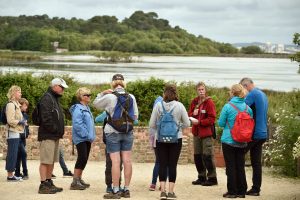Top 5 places in the UK to birdwatch

Before we get started here are some facts about our feathered friends.
- 10,000 — the estimated number of species of birds.
- 2¼ inches — the length of the smallest bird on Earth.
- 1 — the number of eyes that ducks keep open when they sleep.
- 50 — the number of words most parrots can learn.
- 43 mph — the maximum running speed of an Ostrich.
- 20% — the percentage of bird species that migrate long distances each year.
- 100 — the minimum number of words that African Gray parrots can learn.
- 50,000 — the number of acorns that woodpeckers are known to hoard.
If you’re a bird enthusiast, you are going to want to put the following locations on your places to visit list in 2023.
1. RSPB Minsmere, Suffolk
Minsmere is a fantastic coastal nature reserve and is protected in several ways. It is classified as a Site of Special Scientific Interest (SSSI), a Special Protection Area (SPA), a Special Area for Conservation (SAC) and a Ramsar Site. It is home to some of the UK’s rarest bird species at the huge 1,000-acre reserve, which is split into four zones: reedbeds, lowland wet grassland, shingle vegetation and lowland heath.
RSPB Minsmere is perfect for families. Discover nature together in the Wild Zone and Wild Wood Adventure area. The Wild Zone has fun activities including a play tree and child-sized nests. In the Wild Wood, you can build a den or look for minibeasts. In the Wildlife Lookout, you can see some of Minsmere’s special birds.
2. Brownsea Island, Dorset
Brownsea Island is managed in partnership with Dorset Wildlife Trust, who look after the northern part of the island, including the lagoon and surrounding wetland areas. Over 20,000 birds visit Poole Harbour each year to feed and roost. Brownsea holds the record for the UK’s largest-ever recorded overwintering populations of birds such as the black-tailed godwit and avocet. 2022 also saw a Brownsea record for the numbers of spoonbill spotted on the lagoon.
The Island is closed over Winter, but sightings can still be enjoyed from the comfort of your own homes via the Birds of Poole Harbour live webcams.
3. Slimbridge WWT Centre, Gloucestershire
WWT Slimbridge Wetland Centre is set in 120 acres of beautiful wetland reserve in Gloucestershire, on the banks of the Severn estuary. Slimbridge’s reserve is a great place to see rare birds from all over the world.
Winter is a fantastic time to visit Slimbridge, with up to 30,000 wild wintering ducks, geese and swans feeding and roosting on the reserve. Star species this season include Bewick’s swans, white-fronted geese, lapwing, water rail and curlew. Enjoy the winter spectacle on the Tack Piece, look out for hunting goshawk and watch tens of thousands of waders fill the skies. Experience the Bewick’s swans up close at daily Wild Bird Feeds at 4pm, who have flown an epic journey from arctic Russia to spend their winter at Slimbridge. In the summer take a Wild Safari or visit one of the hides and you may see hobby, kingfishers, redshank, brown hares, dragonflies, wild otters, grass snakes and wild orchids.
4. Rutland Water Nature Reserve, Rutland
Rutland Water is home to the UK’s largest annual gathering of birdwatchers: the British Birdwatching Fair is held for three days every August. Search for rare spring migrants, admire fishing ospreys in the summer, enjoy the autumn wader passage and marvel at huge flocks of winter wildfowl. With events year round, walking trails and two visitor centres, you’ll be sure of an immersive wildlife experience for the whole family.
5. The Farne Islands, Northumberland
The wildlife on the National Trust-owned Farne Islands is abundant. Though the islands are most famous for puffins and seals, you’ll see many other species too. Depending on the time of year you visit, you could spot shags, kittiwakes, razorbills, eider ducks and guillemots. The Farne Islands host up to 23 species of birds, including around 37,000 pairs of puffins. Visit in the breeding season (May to July) and you’ll be able to see the endearing birds up close.

We hope you find our Top 5 beneficial and be sure to share with any other likeminded bird lovers.
If you would like to continue birdwatching from the comfort of your own home the RSPB are holding their Big Garden Birdwatch 27-29 January.
The whole family can get involved and it’s easy to take part –
- Watch the birds around you for one hour
- Count how many of each species of bird lands on your patch
- Go online and record what you saw
You don’t have to do much to attract birds to your garden or green space, a bowl of clean water and oats or raisins can make all the difference to helping them survive. Bird tables and hanging bird feeders work well for mixed flocks of finches and tits, whilst apples and berries attract thrushes such as migrant fieldfares and redwings.
The last year has seen avian influenza affect many different species of bird, mostly on our coasts and estuaries, and although it is very unlikely to be present in your garden it’s very important you maintain good hygiene to avoid birds passing on other viruses. Matt Parrott, Visitor Experience Manager at RSPB Minsmere has provided some tips to reduce the spread.
‘Avoid putting out bread as it attracts rodents and soon gets mouldy, and although you can use suet and fat to make homemade bird feeders do not use fats from turkey, chicken or other birds. Replace water each day, especially in freezing temperatures, and clean out old seed and suet from birdfeeders regularly to avoid contamination.’
By taking part in Big Garden Birdwatch you, and hundreds of thousands of other like-minded nature lovers, will be taking action to protect our birds for generations to come.
Sign up for your free guide here.